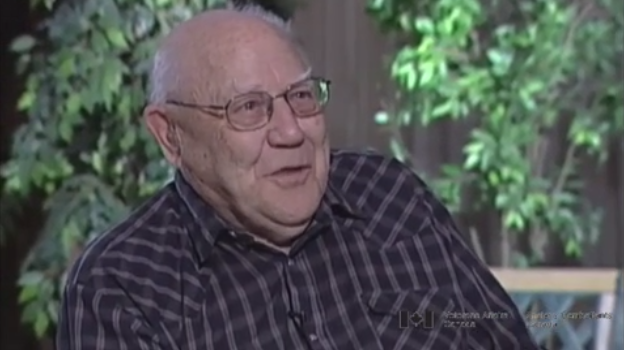A Continuous Roar
Heroes Remember
A Continuous Roar
Transcript
We heard the guns start up, and we knew this was going to happen,
I understand there's 2200 guns firing, that's everything from
anti-aircraft guns to the heavy's and so on. And you hear the
guns start off then you hear the shells come over, and they
whistle different sounds for different shells, different noises
and so on. You got so you pretty well pick out what was coming.
The German shells had a different noise too. Like the 88's they
come in with "zip-bam!" They were very fast, where as the other
ones there whistle as they come in you know. And if you got like
a twenty-five pounder you hear just a slow whistle coming over,
you got into say, a 55 it was a maybe a bit faster whistle, it
was a bigger projectile. And the guys who cleared out Calais,
coastal guns there said that they turned the guns onto them like
that, and they fired and said it sounded like a freight train
coming through a tunnel when it come through the air. I never saw
that. But you get the noise you can hear the guns firing, you can
hear the shells going over you, you hear them explode. And after
they got going it was just continuous roar you know. And I don't
say you could see the shells but you could feel them going over
like you know, there was air motion and so on. In fact, on a
twenty-five pounder, I know if your standing about twenty-five,
thirty feet from the muzzle look out, but 20 feet past the muzzle
you can see that projectile taking off, heading for nine miles
away, they went that far. But you can see the projectiles when
they take, first take off. I guess it's the same with the bigger
guns too, I don't know. But it was an awful noise, just shook,
everything shook, you know, vibrations and so on.
Description
Mr. Tomlin describes the noise during heavy artillery action.
Glen Tomlin
Mr. Tomlin was born in Clinton, Ontario, in 1923. His family moved to Harriston when he was very young. Once he was old enough he worked in a box factory earning $7/week for 60 hours of labour. Despite having had rheumatic fever, which made it impossible for him to walk at a marching pace, Mr. Tomlin was accepted by the army, where he trained as a field gunner. He later switched to infantry, joining the Hard Light Infantry, 9th Brigade, 3rd Canadian Division. Mr. Tomlin's service saw him in several combats in Northern Europe, often engaging the enemy at very close quarters. Mr. Tomlin now resides in Palmerston, Ontario.
Meta Data
- Medium:
- Video
- Owner:
- Veterans Affairs Canada
- Duration:
- 1:46
- Person Interviewed:
- Glen Tomlin
- War, Conflict or Mission:
- Second World War
- Location/Theatre:
- Europe
- Branch:
- Army
- Units/Ship:
- Highland Light Infantry
- Rank:
- Private
- Occupation:
- Gunner
Related Videos
- Date modified:




